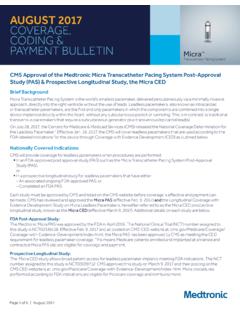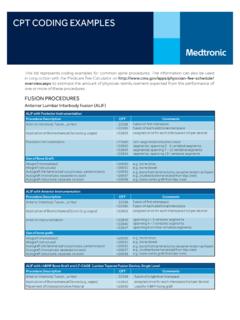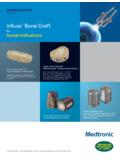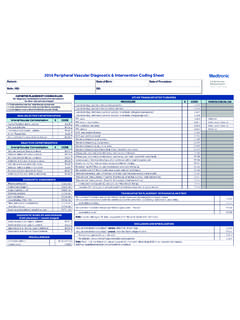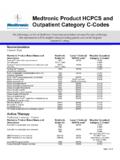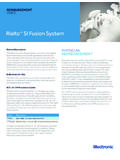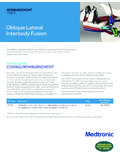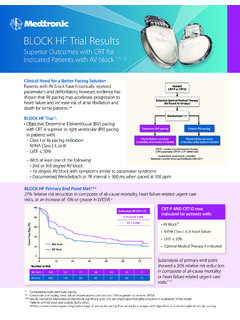Transcription of DURABLE. CONSISTENT. SAFE. - Medtronic
1 DURABLE. CONSISTENT. Admiral Drug-Coated BalloonExcipient: Urea Critical component in delivering solid-phase drug to the : Paclitaxel Proven anti-restenotic Admiral DCB has proven, long-term durable outcomes across multiple clinical trials, as well as across complex patient and lesion types. This strong clinical data may be explained by the mechanism of action. Delivery93% of delivered paclitaxel is retained in solid phase at 24 hours, critical to ensuring prolonged tissue paclitaxel remains in tissue at therapeutic levels through 90 Admiral DCB demonstrates continued trend of smooth muscle cell loss, managing restenosis through 90 reservoirs 28 days following drug delivery Presence of solid-phase paclitaxel reservoirs enables prolonged anti-restenotic effect.
2 SUSTAINED DRUG = SUSTAINED BENEFITTHE SCIENCE BEHIND THE Admiral drug-coated balloons demonstrate best-in-class clinical outcomes with durable performance through 3 years. Admiral DCB shows durable outcomes in primary patency out to 3 years, relative to the PTA control arm. Admiral DCB had a low reintervention rate of , half that found in the PTA control arm at 3 years. Primary Patency: Freedom from clinically driven TLR or freedom from restenosis as determined by Duplex ultrasound peak systolic velocity ratio at 12 months and reported again at 24 and 36 months. The 36-month primary patency was calculated based on Kaplan-Meier estimate. Clinically-driven TLR adjudicated by an independent Clinical Event Committee, blinded to the assigned treatment based on any re-intervention at the target lesion due to symptoms or drop of ABI of 20% or > when compared to post-procedure baseline SFA Trial1 Year2 Year3 YearPrimary Patency to 3 years10 0806040 20 Admiral N= Admiral N= Admiral N=220P TA N=111P TA N=111P TA N= < < < TLR at 3 years10 0 80 60 40 20 0P TA N= SFA Admiral N=220p= SFA TrialPrimary Patency at 12 months10 0806040 20 Admiral N= TA N= p< Admiral N= TA N= p< Admiral drug-coated balloons demonstrate positive, consistent outcomes across trials, complex patients and lesion subgroups.
3 Admiral DCB provides high primary patency and consistently low TLR rates for ISR at 12 Admiral DCB performs consistently across a range of complex patient types at 12 and Mean Lesion Length may be calculated differently, and therefore may not be directly comparable; chart is for illustration only. Overlap exists between the patient populations in the Global ISR Imaging Cohort and the Global ISR M. Brodmann, VIVA 2015. CD-TLR Rate. 2 Medtronic Admiral DCB IFU. Kaplan Meier 360-day TLR Rate at 12 Global DCB ISR Global ISR Imaging Cohort1 Mean Lesion Length cm cmOccluded Lesions TLR for Admiral drug-coated balloons have an excellent safety profile, with superior results relative to Safety OutcomesThousands of patients around the world have been treated with Admiral DCB, the established global market leader in drug-coated are % (n/N).
4 *p values are based on Fisher exact test for superiority with significance level of Freedom from 30-day device- and procedure-related death and target limb major amputation and clinically driven TVR within 36 months 10% Non-inferiority Test Margin with one-sided CI ** Based on sales and use of Admiral DCB ,000+PATIENTS TREATED WITH ADMIRAL ** 3,500+PATIENTS REGISTERED IN CLINICAL STUDIES21 TOTAL SFA Admiral (n=220)PTA (n=111) p-value*Primary safety composite1 (160/197) (66/103)< Device- andprocedure-related (0/197) (0/103)N /ATarget limbmajor (0/197) (0/103)N (4/197) (5/103) Information Admiral Drug-Coated BalloonRef. Number Usable Length 80 cmRef. Number Usable Length 130cmBalloon Diameter (mm) balloon Length (mm)Recommended Introducer Sheath (F)Nominal Pressure (atm)RBP (atm)
5 ADM 040 040 08 PADM 040 040 13P4405814 ADM 040 060 08 PADM 040 060 13P4605814 ADM 040 080 08 PADM 040 080 13P4805814 ADM 040 120 08 PADM 040 120 13P41205814 ADM 040 150 08 PADM 040 150 13P41505814 ADM 050 040 08 PADM 050 040 13P5406814 ADM 050 060 08 PADM 050 060 13P5606814 ADM 050 080 08 PADM 050 080 13P5806814 ADM 050 120 08 PADM 050 120 13P51206814 ADM 050 150 08 PADM 050 150 13P51506814 ADM 060 040 08 PADM 060 040 13P6406814 ADM 060 060 08 PADM 060 060 13P6606814 ADM 060 080 08 PADM 060 080 13P6806814 ADM 060 120 08 PADM 060 120 13P61207814 ADM 060 150 08 PADM 060 150 13P61506814 ADM 070 040 08 PADM 070 040 13P7407814 ADM 070 060 08 PADM 070 060 13P7607814 ADM 070 080 08 PADM 070 080 | Peripheral | endoVenous3033 Campus Drive, N550 Plymouth, MN 55441 USAO rdersTel: + free: + : + : LifeLineCustomer SupportTel: + free: + Technical SupportToll free: + EN 2016 Medtronic .
6 All rights reserved. Medtronic , the Medtronic logo and Further, Together are trademarks of Medtronic . All other brands are trademarks of a Medtronic company. Printed in the USA . For distribution in the USA only. 11/16 Indications for Use The Admiral Paclitaxel-Coated PTA balloon catheter is indicated for percutaneous transluminal angioplasty, after appropriate vessel preparation, of de novo, restenotic, or in-stent restenotic lesions with lengths up to 180 mm in superficial femoral or popliteal arteries with reference vessel diameters of 4-7 Admiral DCB is contraindicated for use in: Coronary arteries, renal arteries, and supra-aortic/cerebrovascular arteries Patients who cannot receive recommended antiplatelet and/or anticoagulant therapy Patients judged to have a lesion that prevents complete inflation of an angioplasty balloon or proper placement of the delivery system Patients with known allergies or sensitivities to paclitaxel Women who are breastfeeding, pregnant or are intending to become pregnant or men intending to father children.
7 It is unknown whether paclitaxel will be excreted in human milk and whether there is a potential for adverse reaction in nursing infants from paclitaxel Use the product prior to the Use-by Date specified on the package. Contents are supplied sterile. Do not use the product if the inner packaging is damaged or opened. Do not use air or any gaseous medium to inflate the balloon . Use only the recommended inflation medium (equal parts contrast medium and saline solution). Do not move the guidewire during inflation of the Admiral DCB. Do not exceed the rated burst pressure (RBP). The RBP (14 atm [1419 kPa]) is based on the results of in vitro testing. Use of pressures higher than RBP may result in a ruptured balloon with possible intimal damage and dissection.
8 The safety and effectiveness of using multiple Admiral DCBs with a total drug dosage exceeding 20,691 g of paclitaxel in a patient has not been clinically evaluated in the SFA This product should only be used by physicians trained in percutaneous transluminal angioplasty (PTA). This product is designed for single patient use only. Do not reuse, reprocess, or resterilize this product. Reuse, reprocessing, or resterilization may compromise the structural integrity of the device and/or create a risk of contamination of the device, which could result in patient injury, illness, or death. Assess risks and benefits before treating patients with a history of severe reaction to contrast agents. The safety and effectiveness of the Admiral DCB used in conjunction with other drug- eluting stents or drug-coated balloons in the same procedure or following treatment failure has not been evaluated.
9 The extent of the patient s exposure to the drug coating is directly related to the number of balloons used. Refer to the Instructions for Use (IFU) for details regarding the use of multiple balloons and paclitaxel content. The use of this product carries the risks associated with percutaneous transluminal angioplasty, including thrombosis, vascular complications, and/or bleeding events. Vessel preparation using only pre-dilatation was studied in the clinical study. Other methods of vessel preparation, such as atherectomy, have not been studied clinically with Admiral DCB. This product is not intended for the expansion or delivery of a Adverse Events The potential adverse effects ( complications) associated with the use of the device are: abrupt vessel closure; access site pain; allergic reaction to contrast medium, antiplatelet therapy, or catheter system components (materials, drugs, and excipients); amputation/loss of limb; arrhythmias; arterial aneurysm; arterial thrombosis; arteriovenous (AV) fistula; death; dissection; embolization; fever; hematoma; hemorrhage; hypotension/hypertension; inflammation; ischemia or infarction of tissue/organ; local infection at access site; local or distal embolic events; perforation or rupture of the artery; pseudoaneurysm; renal insufficiency or failure.
10 Restenosis of the dilated artery; sepsis or systemic infection; shock; stroke; systemic embolization; vessel spasms or recoil; vessel trauma which requires surgical complications of peripheral balloon catheterization include, but are not limited to the following: balloon rupture; detachment of a component of the balloon and/or catheter system; failure of the balloon to perform as intended; failure to cross the systemic effects are not anticipated, potential adverse events that may be unique to the paclitaxel drug coating include, but are not limited to: allergic/immunologic reaction; alopecia; anemia; gastrointestinal symptoms; hematologic dyscrasia (including leucopenia, neutropenia, thrombocytopenia); hepatic enzyme changes; histologic changes in vessel wall, including inflammation, cellular damage, or necrosis; myalgia/arthralgia; myelosuppression; peripheral to the Physician s Desk Reference for more information on the potential adverse effects observed with paclitaxel.
